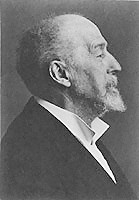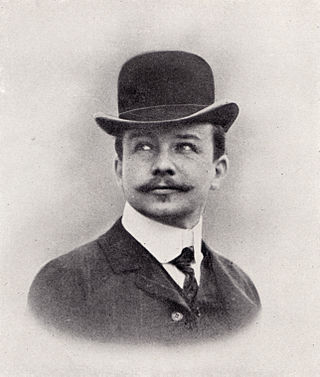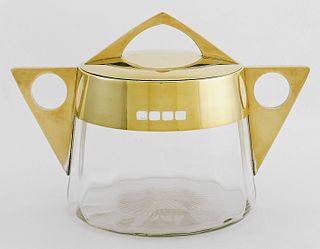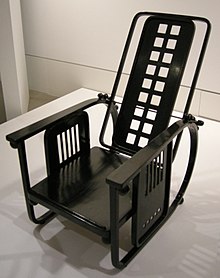
Art Nouveau is an international style of art, architecture, and applied art, especially the decorative arts. The style is known by different names in different languages: Jugendstil in German, Stile Liberty in Italian, Modernisme in Catalan, and also known as the Modern Style in English. It was popular between 1890 and 1910 during the Belle Époque period, and was a reaction against the academic art, eclecticism and historicism of 19th century architecture and decoration. It was often inspired by natural forms such as the sinuous curves of plants and flowers. Other characteristics of Art Nouveau were a sense of dynamism and movement, often given by asymmetry or whiplash lines, and the use of modern materials, particularly iron, glass, ceramics and later concrete, to create unusual forms and larger open spaces.

Otto Koloman Wagner was an Austrian architect, furniture designer and urban planner. He was a leading member of the Vienna Secession movement of architecture, founded in 1897, and the broader Art Nouveau movement. Many of his works are found in his native city of Vienna, and illustrate the rapid evolution of architecture during the period. His early works were inspired by classical architecture. By mid-1890s, he had already designed several buildings in what became known as the Vienna Secession style. Beginning in 1898, with his designs of Vienna Metro stations, his style became floral and Art Nouveau, with decoration by Koloman Moser. His later works, 1906 until his death in 1918, had geometric forms and minimal ornament, clearly expressing their function. They are considered predecessors to modern architecture.

The Wiener Werkstätte, established in 1903 by the graphic designer and painter Koloman Moser, the architect Josef Hoffmann and the patron Fritz Waerndorfer, was a productive association in Vienna, Austria that brought together architects, artists, designers and artisans working in ceramics, fashion, silver, furniture and the graphic arts. The Workshop was "dedicated to the artistic production of utilitarian items in a wide range of media, including metalwork, leatherwork, bookbinding, woodworking, ceramics, postcards and graphic art, and jewelry." It is regarded as a pioneer of modern design, and its influence can be seen in later styles such as Bauhaus and Art Deco.

The Vienna Secession is an art movement, closely related to Art Nouveau, that was formed in 1897 by a group of Austrian painters, graphic artists, sculptors and architects, including Josef Hoffman, Koloman Moser, Otto Wagner and Gustav Klimt. They resigned from the Association of Austrian Artists in protest against its support for more traditional artistic styles. Their most influential architectural work was the Secession Building designed by Joseph Maria Olbrich as a venue for expositions of the group. Their official magazine was called Ver Sacrum, which published highly stylised and influential works of graphic art. In 1905 the group itself split, when some of the most prominent members, including Klimt, Wagner, and Hoffmann, resigned in a dispute over priorities, but it continued to function, and still functions today, from its headquarters in the Secession Building. In its current form, the Secession exhibition gallery is independently led and managed by artists.

Gebrüder Thonet or the Thonet Brothers was a European furniture manufacturer. It continues as a German company, Austrian and Czech (TON).

Joseph Maria Olbrich was an Austrian architect and one of the Vienna Secession founders.

Koloman Moser was an Austrian artist who exerted considerable influence on twentieth-century graphic art. He was one of the foremost artists of the Vienna Secession movement and a co-founder of Wiener Werkstätte.

The Stoclet Palace is a mansion in Brussels, Belgium. It was designed by the Austrian architect Josef Hoffmann for the Belgian financier Adolphe Stoclet. Built between 1905 and 1911 in the Vienna Secession style, it is located at 279–281, Avenue de Tervueren/Tervurenlaan, in the Woluwe-Saint-Pierre municipality of Brussels. Considered Hoffman's masterpiece, the residence is one of the 20th century's most refined and luxurious private houses.
Mundus was the name of a furniture-manufacturing company, active in several places in the Austro-Hungarian Empire, at the end of the 19th century and early 20th century.

Lilly Reich was a German designer of textiles, furniture, interiors, and exhibition spaces. She was a close collaborator with Ludwig Mies van der Rohe for more than ten years during the Weimar period in the 1920s and early 1930s. Reich was an important figure in the early Modern Movement in architecture and design. Her fame was posthumous, as the significance of her contribution to the work of Mies van der Rohe and others with whom she collaborated only became clear through the research of later historians of the field.

Oskar Strnad was an Austrian architect, sculptor, designer and set designer for films and theatres. Together with Josef Frank he was instrumental in creating the distinctive character of the Wiener Schule der Architektur. He stood for a modern concept of "living" for all people, planned and built private dwelling-houses, designed furniture, created ceramics and watercolours and designed sets and props for stage plays and films.

Michael Thonet was a German-Austrian cabinet maker, known for the invention of bentwood furniture.

Josef Hoffmann was an Austrian-Moravian architect and designer. He was among the founders of Vienna Secession and co-establisher of the Wiener Werkstätte. His most famous architectural work is the Stoclet Palace, in Brussels, (1905–1911) a pioneering work of Modern Architecture, Art Deco and peak of Vienna Secession architecture.

The MAK – Museum of Applied Arts is an arts and crafts museum located at Stubenring 5 in Vienna's 1st district Innere Stadt. Besides its traditional orientation towards arts and crafts and design, the museum especially focuses on architecture and contemporary art. The museum has been at its current location since 1871. Since 2004 the building is illuminated in the evenings by the permanent outdoor installation "MAKlite" of American artist James Turrell. In 2015 the MAK became the first museum to use bitcoin to acquire art, when it purchased the screensaver "Event listeners" of van den Dorpel. With over 300.000 objects displayed online, the MAK presents the largest online collection within the Austrian Federal Museums. The audio guide to this museum is provided as a web-based app.

Café Museum is a traditional Viennese café located in the Innere Stadt first district in Vienna. The café opened in 1899. The original interior was designed by renowned architect Adolf Loos. The café became a meeting place for Viennese artists.

Furniture created in the Art Nouveau style was prominent from the beginning of the 1890s to the beginning of the First World War in 1914. It characteristically used forms based on nature, such as vines, flowers and water lilies, and featured curving and undulating lines, sometimes known as the whiplash line, both in the form and the decoration. Other common characteristics were asymmetry and polychromy, achieved by inlaying different colored woods.
Werkstätte Hagenauer Wien - (wHw) - was a family business in Vienna that produced fine, handcrafted objects for decoration and use over its nearly ninety-year history. The workshop closed in 1987 but the company's retail premises, opened in 1938 on Vienna's Opernring, survives today as a museum and shop.

Gisela Falke Von Lilienstein was an Austrian designer who designed ceramics, glassware, jewelry, lighting, and furniture for the Wiener Werkstätte. Her work was exhibited in Vienna Secessionist exhibitions and international expositions.
The Gallia family Hoffman apartment collection is a set of furniture and decorative objects that are the surviving Vienna Secession style contents of the 1913 apartment of wealthy businessman Moritz Gallia and his wife and Hermine, mostly designed by leading architect and designer Josef Hoffman. When the Gallia's children had to flee the Anschluss with Nazi Germany in 1938, they brought what remained with them to Australia, a place 'as far away as they could get', where it was subsequently purchased in 1976 by National Gallery of Victoria, and pieces have been on permanent display since 1984.
Wolfgang Hoffmann (1900–1969) was an Austrian-American architect and designer active in the American modernism movement between 1926 and 1942. His reputation was overshadowed by that of his father, the architect and designer Josef Hoffmann, and ex-wife, Josefine Pola Weinbach Hoffmann, better known as Pola Stout.
















